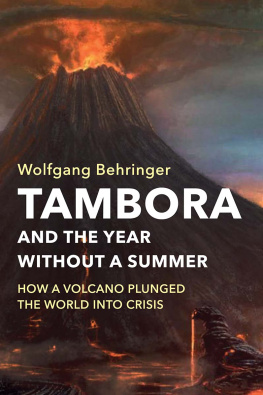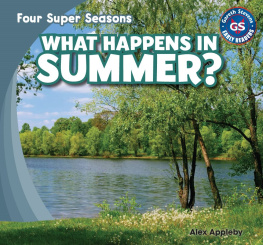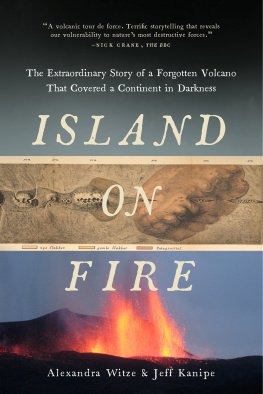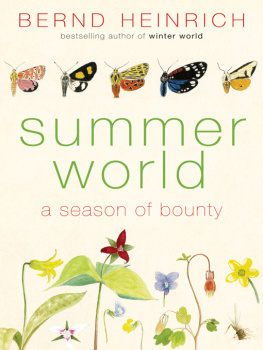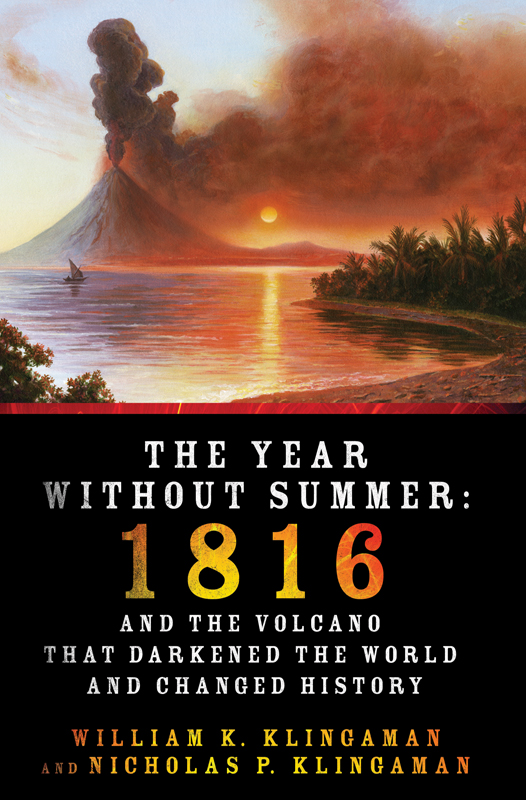
The author and publisher have provided this e-book to you for your personal use only. You may not make this e-book publicly available in any way. Copyright infringement is against the law. If you believe the copy of this e-book you are reading infringes on the authors copyright, please notify the publisher at:
us.macmillanusa.com/piracy.
To Janet and Emma
CONTENTS
THE VOLCANO
J UST BEFORE SUNSET on April 5, 1815, a massive explosion shook the volcanic island of Sumbawa in the Indonesian archipelago. For two hours, a stream of lava erupted from Mount Tambora, the highest peak in the region, sending a plume of ash eighteen miles into the sky.
More than eight hundred miles away, Thomas Stamford Raffles, the lieutenant-governor of Java, heard the blast at his residence and assumed it came from cannon firing in the distance. Other British authorities on the island made the same mistake. Fearing a neighboring village was under attack, the commander of the city of Djogjokarta, in central Java, dispatched troops to repel the invaders. Officials along the coast interpreted the sounds as signals from a ship in distress, and launched rescue boats to look for survivors.
At Makassar on the southwestern tip of Sulawesi, 240 miles northeast of Tambora, the commander of the Benares , a cruiser of the British East India Company, reported a firing of cannon on April 5. The explosions appeared to come from the south; as they continued, the reports seemed to approach much nearer, and sounded like heavy guns occasionally, with slighter reports between. Assuming that pirates were in the area, the Benares put to sea and spent the next three days scouring nearby islands for any signs of trouble, but found nothing. Nearly five hundred miles farther to the east, the British resident on the island of Ternate heard several very distinct reports like heavy cannon, and sent another cruiser, the Teignmouth , to investigate. It, too, returned empty-handed.
British authorities might have been excused for assuming that the threatening sounds came from potential enemies rather than the earth itself. They were not yet accustomed to the frequent volcanic eruptions that plagued the Indonesian islands. Britain had gained control of Java and the surrounding islands less than four years earlier, when British troops overwhelmed a vastly outnumbered band of French defenders who themselves had held Java for only a short time, having taken it from the Dutch when France conquered the Netherlands in 1794. By the spring of 1815, neither the government in London nor the British East India Company was entirely certain that they wanted to keep the island, since the expense of administering and defending it had outweighed the commercial benefits thus far.
Responsibility for British policy on the scene lay squarely with Raffles himself. The son of a ships captain, Raffleswho actually was born at sea, off the coast of Jamaicadreamt of a British maritime empire throughout South Asia, an Eastern insular Empire that would provide new markets for English cotton and woolen textiles, and a profitable supply of coffee and sugar for Europe. It was Raffles who had persuaded the governor general of India, Lord Minto, to seize Java in the first place. Raffles also hoped to use Java as an avenue to improve relations with Japan, which he viewed as a rising Asiatic power. Meanwhile, heeding Mintos advice to do as much good as we can while governing Java, Raffles reformed the colonial administration of the island, limiting the powers of the great landowners over their tenants and ameliorating the worst abuses of slavery while banning the importation of slaves under fourteen years of age.
But Raffles interests in the region extended beyond politics and commerce. After years of study, he was sufficiently fluent in the Malay language to conduct discussions directly with local chieftains. He regularly employed botanists and zoologists to obtainat his own expensespecimens of local flora and wildlife, some of which he had preserved in spirit and shipped back to Britain. In his capacity as president of the Batavian Society, dedicated to the study of Javas natural history, Raffles frequently toured the island and recorded his observations of geological phenomena. Several weeks before Mount Tambora erupted, Raffles became the first European to ascend a nearby mountain known as Gunong Gede; by using thermometers to measure the difference in temperature between the base and the peak, Raffles and his companions determined that they had climbed at least seven thousand feet. We had a most extensive prospect from the summit, he subsequently wrote to a friend. The islands all round were quite distinct and we traced the sea beyond the southernmost point of Sumatra; the surf on the south coast was visible to the naked eye.
So Raffles scientific curiosity was piqued when the cannonlike explosions from the southeast continued throughout the night of April 5 and into the morning hours. Shortly after dawn, a light rain of ash provided evidence that a volcano somewhere in the region had erupted. Few suspected Mount Tambora. It was generally believed that Tambora was extinct, although natives living in the nearest village had reported rumblings from deep inside the mountain during the past year. Besides, few on Java believed that such powerful sounds could have come from a volcano several hundred miles away. As Raffles subsequently noted, the sound appeared to be so close, that in each district it seemed near at hand, and was generally attributed to an eruption either from the mountains Merapi, Klut, or Bromo.
As a fog of ash drifted across Java, the sun faded; the warm, humid air grew stifling, and everything seemed unnaturally still. The oppressive pressure, Raffles noted, seemed to forbode an earthquake. Over the next several days, however, the explosions gradually subsided. Volcanic ash continued to fall, but in diminishing quantities. Relieved, Raffles returned to his routine administrative duties.
* * *
F AR from Tambora and the island of Java, a different sort of shock greeted the rulers and citizens of Europe in April 1815: Napolon had returned to Paris.
The Emperor had spent the past year ruling the island of Elba, a rocky, desolate piece of real estate of no discernible strategic importance off the coast of Italy. Sixteen miles long and only seven miles across at its widest point, Elba in the early nineteenth century was home mainly to goats, deserted ruins, a variety of vines and scraggly shrubs on arid hillsides, and approximately twelve thousand impoverished peasants with a well-deserved reputation for being extremely irritable and almost universally ignorant. Its primary natural resource was rocks. One French observer who visited Elba shortly before Napolons arrival warned that the islands unremittingly inhospitable topography was likely to fatigue the senses and impart sensations of sorrow to the soul.
Napolon had been consigned to Elba by the victorious allied coalition of Britain, Prussia, Austria, and Russia shortly after abdicating the French throne on April 6, 1814. (Perhaps as an ironic jest, they allowed him to retain the title of Emperor.) But the Allied statesmen who gathered at Vienna to sort out the consequences of nearly two decades of war neglected to provide a jailer, or even an effective network of informants to keep them apprised of Napolons movements. Encouraged by press reports of widespread popular disaffection with the restored Bourbon monarchy in Paris, Napolon decided that his former subjects would welcome him back. And so on February 25, 1815, accompanied by slightly more than a thousand troops, forty horses, and four cannon, Napolon sailed away from Elba unopposed.


